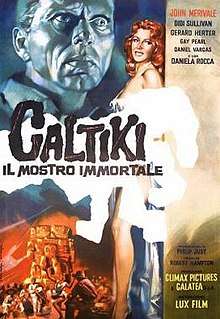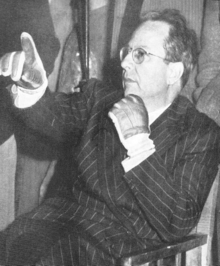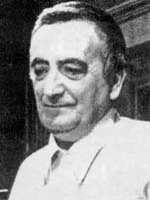Caltiki – The Immortal Monster
| Caltiki, The Immortal Monster | |
|---|---|
 Italian theatrical release poster | |
| Produced by | Nello Santi |
| Screenplay by |
|
| Starring | |
| Music by | Roberto Nicolosi[1] |
| Cinematography | Mario Bava |
| Edited by | Mario Serandrei[1] |
Production company |
|
| Distributed by | Lux Film |
Release date |
|
Running time | 76 minutes[1] |
| Country |
|
| Box office | ₤94.15 million |
Caltiki, The Immortal Monster (Italian: Caltiki, il mostro immortale) is a 1959 black-and-white science fiction-horror film. The film's storyline concerns a team of archaeologists investigating Mayan ruins who come across a creature that is a shapeless, amorphous blob. They manage to defeat it using fire, while keeping a sample of the creature. Meanwhile, a comet is due to pass close to the Earth, the very same comet that passed near the Earth at the time the Mayan civilization collapsed, raising the question: "Is there a connection between the creature and the comet"?
Made with the a foreign audience in mind, Galatea Film started exploring other genres after the success of their film Hercules (1958) which led to Freda being tasked to direct Caltiki, The Immortal Monster. Freda left the project during filming, later explaining that he wanted to give his friend, the cinematographer Mario Bava a chance to direct and earn more on the project. In interviews done long after the release of the film, both Freda and Bava gave conflicting opinions on who should be considered the real director Caltiki. Various historians and ministerial papers suggest that Bava did create a large amount of footage of the film involving death scenes, the monster, matching shots and special effects scenes. The film was released in Italy on 8 August 1959 where it grossed less than Bava's and Freda's previous genre collaboration I Vampiri.
Plot
A delirious archaeologist stumbles into his group's camp without his partner, both of whom have been exploring a nearby cave. He quickly goes mad, requiring hospitalization. Their interest piqued by this strange turn of events, the group sets out for the cave.
Once there, they find a deep pool of water, behind which is a large statue of Caltiki, the vengeful Mayan goddess who was ceremonially presented with human sacrifices. Hoping to find artifacts, the group sends one of their own down into the pool. At the bottom, he finds a menagerie of skeletons clad in gold jewelry. Running out of oxygen, he comes back up, clutching as much gold as he can carry. Although wishing that he not go down again, he insists on doing so, suggesting that they could become wealthy from the treasures below. Relenting, they let him descend once more. As he collects more and more treasure, his cable to the surface suddenly begins to move erratically. Fearing for his safety, the group pulls him back to the surface, only to find, upon removing his face mask, that his flesh has been reduced to a decayed mass over his skeleton.
Moments later, the shapeless creature that attacked him rears up from the pool, attempting to digest anyone within reach. One of the group is briefly caught by the arm but is then rescued. As the team escapes, the shapeless mass begins to crawl out of the cave. Nearby, there is a tanker truck full of gasoline. One of the scientists drives the truck directly into the moving mass, which violently explodes and sets fire to the blob, destroying it.
The team returns to Mexico City to take their injured colleague to a hospital. Still on his arm is a small piece of the blob, which is slowly digesting him. The surgeons carefully remove the creature, wrapping it up. They find that his arm is nothing more than a few moist scraps of flesh still connected to the underlying bones. After further experimenting on the creature, scientists discover that it is a unicellular bacterium that quickly grows when in the presence of radiation. A comet emitting radiation, that crosses Earth's path only once in every 850 years, is quickly approaching. At the comet's closest approach to Earth, the remaining piece of the blob removed during the surgery, begins expanding to an enormous size and reproducing. Unfortunately, the removed sample of creature is stored in the home of expedition member Dr. John Fielding (John Merivale).
While attempting to convince the Mexican government to send its army to destroy the reproducing blobs, Fielding is arrested but manages to escape. A colleague finally convinces the authorities to sound an alarm because the multiplying creatures will soon be beyond even their ability to control. The government marshals a regiment of soldiers equipped with flamethrowers and jeeps and sends them to Dr. Fielding's home. Upon their arrival, they find that the amorphous blobs have continued to multiply and have overrun the house and grounds. Dr. Fielding's wife and child have been forced to hide on a second-floor window ledge to escape being devoured. Fielding arrives just in time to save them, just as the arrayed soldiers lay waste to the creatures with torrents of fire.
Cast
- John Merivale as Dr. John Fielding
- Didi Perego as Ellen Fielding
- Gérard Herter as Max Gunther
- Daniela Rocca as Linda
- Giacomo Rossi-Stuart as Prof. Rodriguez's assistant
- Daniele Vargas as Bob (expedition member)
- Vittorio André as Prof. Rodriguez
- Nerio Bernardi as Police inspector
- Arturo Dominici as Nieto (expedition member)
Production
Background and development
After the release of I Vampiri, Freda took on another new genre, the science fiction film with his next genre film Caltiki - The Immortal Monster.[2][3] Very few sound films in Italy were science fiction at this point, with Sergio Corbucci's comedy film Baracca e burattini made in 1954, Steno's Totò nella luna and The Day the Sky Exploded from 1958.[3] Caltiki was produced by Nello Santi for Galatea Film who were interested in exploring new genres of film after the success of Hercules (1957), and produced Caltiki with foreign markets in mind.[3] Not mentioned in any credits or ministerial papers, European sources list the participation of the French company Climax Film in the production.[3] Prints in the United States of the film stated the film is a "Samuel Schneider presentation" leading to some sources speculating that the film was an Italian and United States co-production.[4]
Director


Director Riccardo Freda was angered by the way producers and other filmmakers had his cinematographer Mario Bava work on previous films,[5] specifically films of Pietro Francisci.[6] Freda concocted a way to push Bava into the director's chair of Freda's next film, Caltiki, The Immortal Monster; he left the project early.[5] Bava had been hired again as the film's cinematographer, while Filippo Sanjust was hired as the film's screenwriter, having co-written Freda's previous film Beatrice Cenci (1956).[7] Freda also contributed to the script without credit.[1]
Specific information on how much Freda and Bava directed the film differ between interviews and recollections. Freda noted with an interview with Luigi Cozzi in 1971 that he "left it when there were just two days of shooting left. I did shoot it yes, but it's Bava's type of film. I don't enclose it in my body of work. The only thing I remember with pleasure about it are the statues that decorated the sets: I sculpted them myself."[6] Bava described Caltiki, The Immortal Monster as "my very first film" while noting that Freda had fled the set "because everything was falling to pieces. I managed to carry it out, patching it up here and there".[8] Cozzi commented on his interview with Freda in 2004, stating that his own words were misinterpreted and that "the truth is only one: the director of Calitiki il mostro immortale is Riccardo Freda, full stop. Mario Bava did take care of the cinematography, the special effects and directed the scenes with the miniatures (that is, mostly the tanks....), and in addition to that he filmed some shots of soldiers with flame throwers. That's all, and of course it cannot be enough to say that Bava directed that movie."[6] Cozzi also stated that Bava spoke about the film stating that "I did not direct Caltiki. The director of that movie is Freda. Only at a certain point, after principal shooting ended, Freda started editing the picture and then he had a big argument with the producer [...] Then Freda walked out."[6] Bava statement from Cozzi than noted that Bava finished some special effects shot, scenes with soldiers with flame throwers for the ending of the film and declared "that does not mean I was the director of Caltiki: that is a Riccardo Freda film."[6] According to Bava's biographer Tim Lucas, Freda's walk off left "two or three weeks of filming" leaving Bava to shoot over 100 special effects shots for a 76 minute long production.[6]
Massimo De Rita who worked as a unit manager for Galatea spent time on the set of Caltiki and opined that "at 90 percent Bava was also the director of Caltiki. Freda was away, he didn't know anything about what Bava was contriving."[9] De Rita noted that Bava told actors what to do and that Bava shot all the connecting shots with the monster and all the death scenes.[9] Ministerial papers also note the Bava and Freda's roles in the film.[9] The final balance in the film assigns Freda 5 million lire instead of the initial 6 and that Bava was paid 6.250 million lire instead of his initial 3 million.[9]
Release
Caltiki - The Immortal Monster was released theatrically in Italy on the 8 August 1959 where it was distributed by Lux Film.[1] In Italy the film was less successful than Freda's and Bava's film I Vampiri, which had grossed ₤125.3 million Italian lire.[10][11] Caltiki grossed a total of 94.15 million lire domestically.[1]
The film was distributed theatrically in the United States in September 1960 by Allied Artists as Caltiki, The Immortal Monster.[4] The English-language dub of the film was created in New York by Titra Studios, which dubbed many of the Italian films from this period.[12] It was released in the United Kingdom in 1962.[4]
Home media
Caltiki - The Immortal Monster was published as a photonovel in the magazine I Vostri Film in the July 1, 1962 issue.[4] The film was released on DVD and blu-ray by Arrow Video on April 11, 2017.[13]
Critical reception
In a contemporary review, The Monthly Film Bulletin commented that "phony sets, bad acting and limitations of a small budget seriously hamper the first half" and that "once the monster asserts itself things begin to liven up."[14] The review concluded that the film was "so incredibly banal that it almost entertains."[14]
AllMovie gave the film a generally positive review, calling it "a neat and compelling science fiction-horror amalgam, squeezing cosmology together with archeology and myth to create a genuinely fascinating and original thriller."[12] In Phil Hardy's book Science Fiction (1984), a review described the film as a "minor outing [...] though the acting is routine and the script leaden, Bava injects a few stylish flourishes."[15] Slant Magazine stated that the film "remains an impressive showcase for Bava's inimitable skills behind the camera, in particular his uncanny ability to craft moody atmosphere and some extremely grisly imagery (for 1959, anyhow) out of the simplest and most frugal of cinematic means."[16]
See also
References
Citations
- 1 2 3 4 5 6 7 8 9 Curti 2017, p. 315.
- ↑ Curti 2017, p. 141.
- 1 2 3 4 Curti 2017, p. 142.
- 1 2 3 4 Curti 2017, p. 146.
- 1 2 Howard 2014, p. 23.
- 1 2 3 4 5 6 Curti 2017, p. 143.
- ↑ Howard 2014, p. 24.
- ↑ Howard 2014, p. 172.
- 1 2 3 4 Curti 2017, p. 144.
- ↑ Curti 2015, p. 21.
- ↑ Shipka 2011, p. 27.
- 1 2 Eder, Bruce. "Caltiki - Il Mostro Immortale (1959)". AllMovie. Retrieved 20 November 2015.
- ↑ Gingold, Michael (7 March 2017). "Complete details announced for Arrow Video's Blu-ray House duo, Caltiki and more!". Rue Morgue. Retrieved 19 May 2017.
- 1 2 "Immortal Monster, The "(Caltiki, il Mostro Immortale)"". Monthly Film Bulletin. London. 29 (336): 39. 1962. ISSN 0027-0407.
- ↑ Hardy 1984, p. 187.
- ↑ Wilkins, Budd (April 30, 2017). "Caltiki, the Immortal Monster". Slant Magazine. Retrieved May 25, 2017.
Bibliography
- Curti, Roberto (2015). Italian Gothic Horror Films, 1957–1969. McFarland. ISBN 978-1-4766-1989-7.
- Curti, Roberto (2017). Riccardo Freda: The Life and Works of a Born Filmmaker. McFarland. ISBN 1476628386.
- Hardy, Phil, ed. (1984). Science Fiction. New York : Morrow. ISBN 0-688-00842-9.
- Howard, Troy (2014). The Haunted World of Mario Bava. Midnight Marquee Press, Inc. ISBN 978-1-936168-45-3.
- Paul, Louis (2005). Italian Horror Film Directors. McFarland. ISBN 978-0-7864-8749-3.
- Mitchell, Charles P. (2001). The Complete H.P. Lovecraft Filmography. Greenwood Publishing Group. ISBN 0313316414.
- Shipka, Danny (2011). Perverse Titillation: The Exploitation Cinema of Italy, Spain and France, 1960–1980. McFarland. ISBN 978-0-7864-4888-3.
- Warren, Bill. Keep Watching the Skies: Science Fiction Films of the Fifties, 21st Century Edition. 2009. Jefferson, North Carolina: McFarland & Company,(First Editions Vol. 1, 1982, Vol. 2, 1986). ISBN 0-89950-032-3